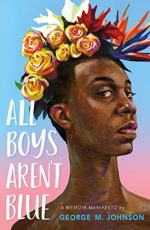|
This section contains 715 words (approx. 2 pages at 400 words per page) |

|
All Boys Aren't Blue: A Memoir-Manifesto Summary & Study Guide Description
All Boys Aren't Blue: A Memoir-Manifesto Summary & Study Guide includes comprehensive information and analysis to help you understand the book. This study guide contains the following sections:
This detailed literature summary also contains Topics for Discussion on All Boys Aren't Blue: A Memoir-Manifesto by George M. Johnson.
The following version of this book was used to create this study guide: Johnson, George M. All Boys Aren’t Blue. Farrar Straus Giroux Books for Young Readers, an imprint of Macmillan Publishing Group. New York, NY. First Edition. 2020.
In his initial Note, Johnson writes that “the word nigger or nigga appears, sometimes in full and sometimes abbreviated as n****. The same is true for fag and faggot, and their abbreviations” (viii). He goes on to say that he has done so “for specific emotional and intellectual effect” and asks that readers who do not identify as “Black, African American, or queer” to not use those terms in full, saying that to do so can be harmful. He suggests using “common abbreviations like n-word or f-word instead” (viii). For the purposes of this analysis, then, quotes using said words will appear as the author has written them. Analysis of the author’s work will use the abbreviations he suggests. Also, in the text he consistently capitalizes “Black” but does not do so for “queer.” This analysis will follow that pattern of usage.
Also in the Author’s Note, Johnson comments that his intention was “to give a voice to so many from marginalized communities” - e.g. Black and/or queer youth – “whose experiences have not yet been captured between the pages of a book” (viii). The Note is followed by an Introduction, in which Johnson sketches in his early experiences of being Black and queer, and how his efforts at reconciling those two sides of himself eventually resulted in him being able to tell “the story of George Matthew Johnson … a story for us all” (14).
In the first of the book’s four parts, identified as “acts,” Johnson describes the circumstances of his childhood. He references his home and family life, and the fact that he was frequently cared for by his mother’s mother, whom he refers to as Nanny. He also describes relationships with his extended family, as well as his relationships with his Blackness and what he came to realize was his queerness. He knew he was different, he says, from a very young age, and so did his family. They treated him with compassion and with an apparent intention of making him feel safe and loved. Even so, he says, he still believed that what he was feeling was essentially wrong, and did everything in his power to keep it secret.
In the book’s second act, Johnson’s emphasis is on relationships with individual members of his family. The text here includes open letters to his younger brother and mother, as well as details about his relationships with his father and with Nanny. There is also a recounting of his relationship with a transgender relative named Hope, and references to how there seems to have been a relatively large number of queer people on his mother’s side of the family.
In the book’s third act, Johnson’s focus is on his experiences in high school. While he puts significant narrative focus onto his experiences of a first same-sex crush and his experience of coming out, the primary focus here is on his experience of being sexually abused by a male cousin. Then, in the book’s fourth act, Johnson’s focus is on his experiences in university, where he hoped and believed he would feel safe enough to come out as queer but where he found himself, at times, as feeling like it was unsafe to do so. Eventually, he says, he found safety enough to be his own kind of masculine within the boundaries of a black fraternity, a set of circumstances in which he started the process of coming out to friends – or rather, to his “brothers” in the fraternity.
Finally, Johnson concludes with an Afterword, in which the author references both the safety and comfort that he found within his family and the fact all the members of his family, including himself, struggled with difficult choices around navigating the intersection between queerness and blackness. He also describes the different facets and meanings of the book’s title, specifically referencing the various implications and connotations of the term “blue,” and how they do, and do not, apply to him and to his experiences.
Read more from the Study Guide
|
This section contains 715 words (approx. 2 pages at 400 words per page) |

|



